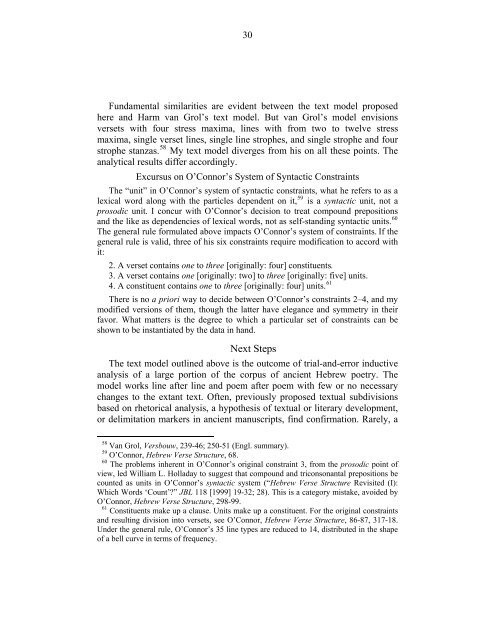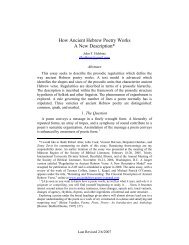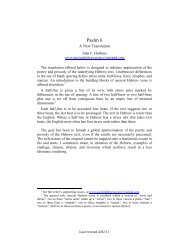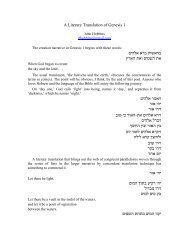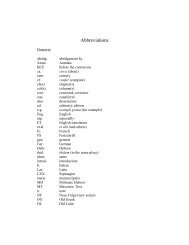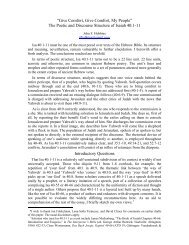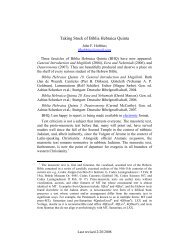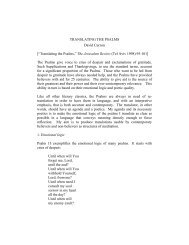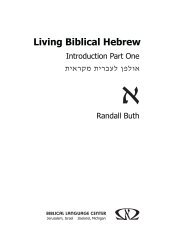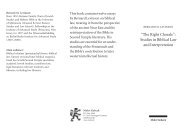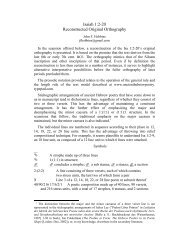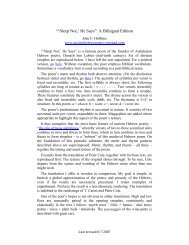Here - Ancient Hebrew Poetry - Typepad
Here - Ancient Hebrew Poetry - Typepad
Here - Ancient Hebrew Poetry - Typepad
- No tags were found...
You also want an ePaper? Increase the reach of your titles
YUMPU automatically turns print PDFs into web optimized ePapers that Google loves.
30Fundamental similarities are evident between the text model proposedhere and Harm van Grol’s text model. But van Grol’s model envisionsversets with four stress maxima, lines with from two to twelve stressmaxima, single verset lines, single line strophes, and single strophe and fourstrophe stanzas. 58 My text model diverges from his on all these points. Theanalytical results differ accordingly.Excursus on O’Connor’s System of Syntactic ConstraintsThe “unit” in O’Connor’s system of syntactic constraints, what he refers to as alexical word along with the particles dependent on it, 59 is a syntactic unit, not aprosodic unit. I concur with O’Connor’s decision to treat compound prepositionsand the like as dependencies of lexical words, not as self-standing syntactic units. 60The general rule formulated above impacts O’Connor’s system of constraints. If thegeneral rule is valid, three of his six constraints require modification to accord withit:2. A verset contains one to three [originally: four] constituents.3. A verset contains one [originally: two] to three [originally: five] units.4. A constituent contains one to three [originally: four] units. 61There is no a priori way to decide between O’Connor’s constraints 2–4, and mymodified versions of them, though the latter have elegance and symmetry in theirfavor. What matters is the degree to which a particular set of constraints can beshown to be instantiated by the data in hand.Next StepsThe text model outlined above is the outcome of trial-and-error inductiveanalysis of a large portion of the corpus of ancient <strong>Hebrew</strong> poetry. Themodel works line after line and poem after poem with few or no necessarychanges to the extant text. Often, previously proposed textual subdivisionsbased on rhetorical analysis, a hypothesis of textual or literary development,or delimitation markers in ancient manuscripts, find confirmation. Rarely, a58 Van Grol, Versbouw, 239-46; 250-51 (Engl. summary).59 O’Connor, <strong>Hebrew</strong> Verse Structure, 68.60 The problems inherent in O’Connor’s original constraint 3, from the prosodic point ofview, led William L. Holladay to suggest that compound and triconsonantal prepositions becounted as units in O’Connor’s syntactic system (“<strong>Hebrew</strong> Verse Structure Revisited (I):Which Words ‘Count’?” JBL 118 [1999] 19-32; 28). This is a category mistake, avoided byO’Connor, <strong>Hebrew</strong> Verse Structure, 298-99.61 Constituents make up a clause. Units make up a constituent. For the original constraintsand resulting division into versets, see O’Connor, <strong>Hebrew</strong> Verse Structure, 86-87, 317-18.Under the general rule, O’Connor’s 35 line types are reduced to 14, distributed in the shapeof a bell curve in terms of frequency.


